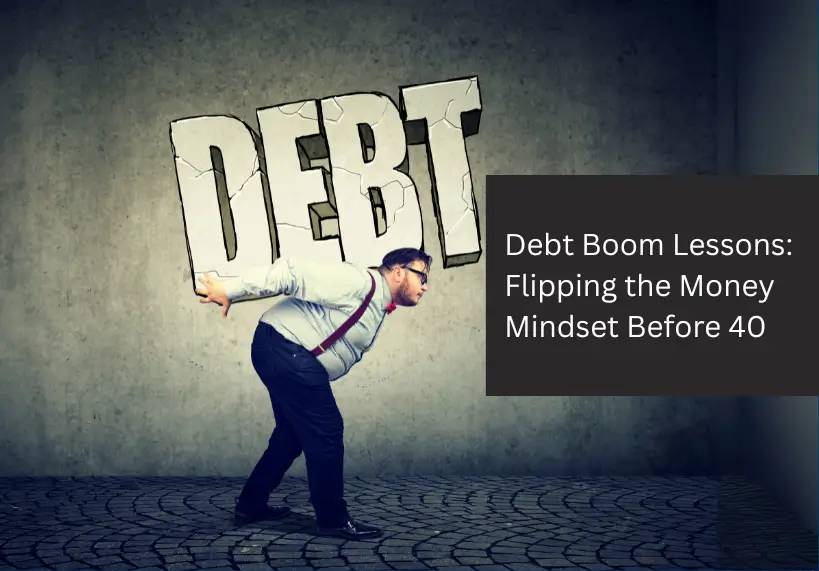
Over the past decade, India has witnessed an unprecedented rise in household debt. From credit cards and Buy Now, Pay Later (BNPL) schemes to instant personal loans, borrowing has become the go-to solution for many salaried professionals. Easy access to credit is empowering, but it has also created new financial risks—especially for millennials and professionals under 40 who are still building wealth and financial stability.
If you fall in this category, it’s time to rethink your money mindset. Borrowing isn’t inherently negative—it can be a smart financial move when used responsibly. But over-leveraging without planning can spiral into late fees, stress, and even a damaged credit score.
Understanding the Debt Boom in India
According to recent data, household debt in India has steadily climbed, with unsecured loans forming a growing share of borrowing. Unsecured loans include credit cards, BNPL schemes, and personal loans for salaried professionals—products that don’t require collateral. For many urban professionals, their speed and convenience make them attractive, often disbursing funds in just hours.
However, this convenience can also lead to over-borrowing. With multiple EMIs running simultaneously, many professionals struggle with repayment discipline. Rising delinquencies in unsecured loans highlight the danger of treating credit as an extension of income rather than a financial tool.
Why Millennials Are More Vulnerable
The millennials debt India story is shaped by lifestyle aspirations and financial realities. Millennials and younger professionals face higher costs of living, student loan repayments, and expensive urban rentals. Add to this a desire for instant gratification—whether it’s a new smartphone, travel plans, or luxury items—and the reliance on credit becomes obvious.
Unlike older generations who preferred saving before spending, millennials often use loans as a way to “fast-forward” their aspirations. While this isn’t inherently wrong, it creates long-term risks if there’s no repayment strategy. Using tools like a personal loan EMI calculator before taking on new debt can help ensure financial stability instead of financial stress.
Signs That Your Money Mindset Needs a Flip
Many borrowers under 40 don’t even realize they’re trapped in unhealthy credit cycles. Some early warning signs include:
- Paying only minimum dues on credit cards each month.
- Taking new loans to pay off old EMIs.
- Borrowing for non-essential lifestyle expenses.
- Ignoring interest rates and terms when signing up for loans.
If you see yourself in any of these patterns, it’s time to flip your approach.
Flipping the Money Mindset
Reversing the cycle of debt requires a mindset shift. Here’s how you can start:
1. Borrow with purpose – Avoid borrowing for lifestyle luxuries. If you already have multiple EMIs, consider a debt consolidation loan to simplify repayments.
2. Plan with tools – Use EMI calculators to test affordability before applying. It’s better to know upfront whether an EMI fits into your budget than to struggle later.
3. Compare costs – Review personal loan interest rates across lenders. Even a small difference in rates can make a big impact on long-term repayments.
4. Think emergencies, not luxuries – Instead of using high-interest credit cards during health emergencies, consider a dedicated medical loan.
5. Build financial literacy – Investing time in improving financial literacy India ensures you make informed, rational decisions instead of impulsive ones.
Practical Strategies for Borrowers Under 40
Flipping your mindset isn’t just about avoiding debt—it’s about using it strategically. Here are practical approaches:
- Set borrowing rules: Only borrow for assets or emergencies, not lifestyle expenses.
- Budget with EMI caps: Limit your EMIs to 30–35% of your take-home salary.
- Track debt regularly: Use budgeting apps or simple spreadsheets to track every loan and repayment date.
- Automate repayments: Avoid late penalties by setting up auto-debit for your EMIs.
- Prioritize high-interest loans: Pay off credit cards or short-term loans before longer, low-interest debt.
By following these steps, borrowers can transition from credit dependency to financial confidence.
How Responsible Borrowing Helps
Responsible borrowing doesn’t mean avoiding loans altogether. In fact, the right unsecured loan at the right time can help you:
- Handle unexpected emergencies.
- Consolidate high-interest debt into a manageable repayment structure.
- Build a positive credit history when repaid on time.
- Fund professional or personal growth without disrupting savings.
The key difference is in the planning. Borrowing without strategy creates stress; borrowing with purpose creates stability.
Conclusion
The debt boom has shown us that credit can either empower or overwhelm. For borrowers under 40, the deciding factor lies in their money mindset. When you treat loans as tools instead of lifelines, you unlock financial flexibility without falling into debt traps.
This is where trusted digital lenders like LoanTap add value. With products such as loans for salaried professionals, debt consolidation, and emergency financing, LoanTap helps borrowers align credit with their financial goals. Add to that transparent terms, supportive repayment options, and easy-to-use tools like EMI calculators, and you get a partner that helps transform borrowing into a growth enabler rather than a financial burden.
FAQs
1. Why is household debt in India rising so fast?
Easy access to credit, rising lifestyle costs, and urban living expenses have fueled borrowing. BNPL schemes and credit card usage also contribute.
2. Is it safe for millennials to take unsecured loans?
Yes, provided repayment is planned. Unsecured loans are best suited for emergencies or productive uses, not discretionary spending.
3. How can I choose the right personal loan?
Compare personal loan interest rates, fees, and repayment options. Using a personal loan EMI calculator before applying helps understand the affordability.
4. What is the benefit of debt consolidation?
A debt consolidation loan allows you to merge multiple EMIs into one, making repayment simpler and reducing the risk of missed payments.
5. How does financial literacy help reduce debt stress?
Strong financial literacy equips borrowers with the ability to budget, compare loans, and plan repayment effectively—helping them stay out of debt traps.
6. Should I avoid loans completely if I’m under 40?
Not at all. Loans, when used smartly, can help in emergencies, investments, or consolidating high-interest debt. The focus should be on borrowing responsibly.
7. How can platforms like LoanTap help me borrow smartly?
LoanTap provides tailored credit solutions for salaried professionals, with flexible tenures, transparent pricing, and online tools that make repayment planning easier.








